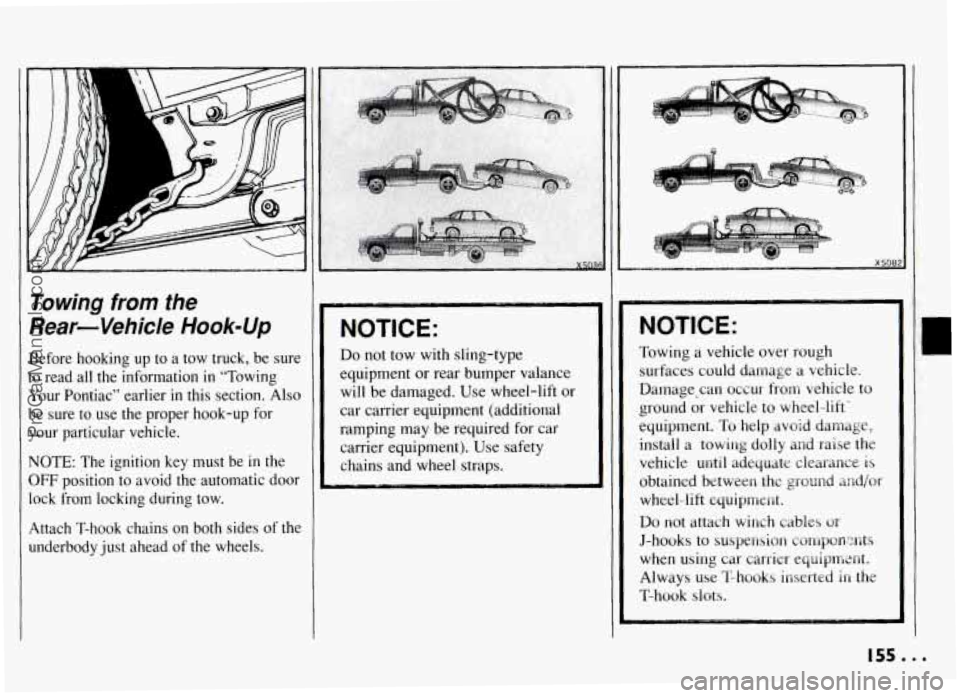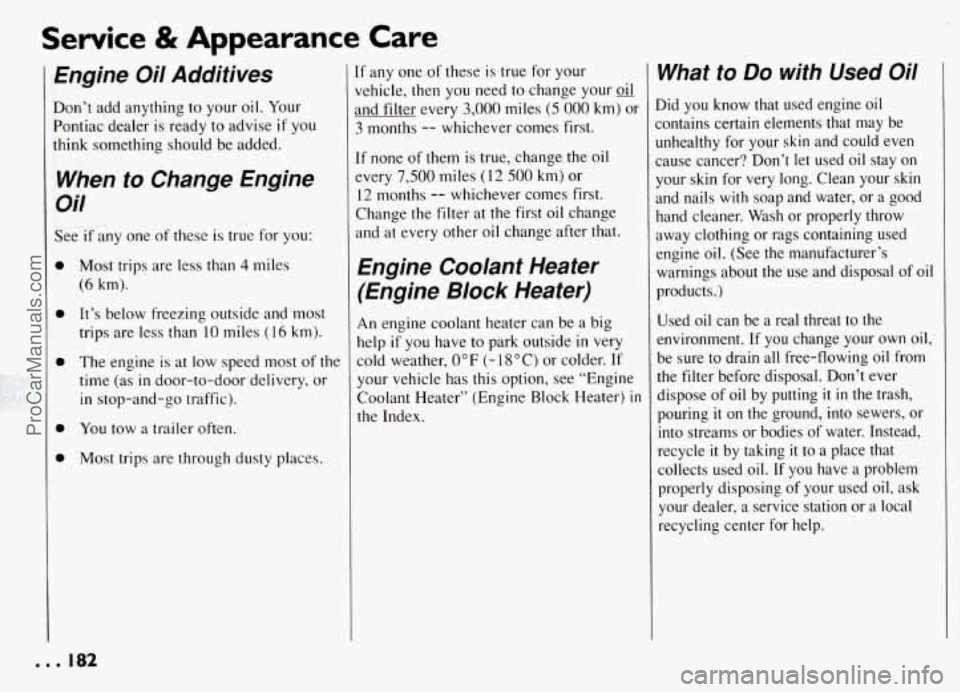Page 156 of 274

Towing from the
Rear-Vehicle Hook-Up
Before hooking up to a tow truck, be sure
to read all the information
in “Towing
Your Pontiac” earlier
in this section. Also
be sure to use the proper hook-up for
your particular vehicle.
NOTE: The ignition key must be in the
OFF position to avoid the automatic door
lock from locking during tow.
Attach T-hook chains on both sides of the
underbody just ahead of the wheels.
NOTICE:
Do not tow with sling-type
equipment or rear bumper valance
will be damaged. Use wheel-lift or
car carrier equipment (additional
ramping may be required for car
carrier equipment). Use safety chains and wheel straps.
32
NOTICE:
Towing a vehicle over rough
surfaces
could damage a vehicle.
Damage
occur from vehicle to
ground or vehicle to wheel-lift’
equipment.
To help avoid damage,
install a towing dolly and raise the
vehicle
until adequate clearance is
obtained between the ground md/w
wheel-lift equipment.
Do not attach winch cables or
J-hooks to suspension
componxmts
when using car carrier equipment.
Always
use T-hooks inserted in the
T-hook slots.
155...
ProCarManuals.com
Page 163 of 274
Problems on the Road
Changing a Flat Tire
If a tire goes flat, avoid further tire and
wheel damage
by driving slowly to a level
place. Turn on your hazard warning
flashers.
The following steps will tell you how to
use the jack and change a tire.
The equipment you’ll need is in the trunk.
1. Turn the center retainer nut on the
compact spare tire housing
counterclockwise
to remove it, then
lift the tire cover. You
will find the
jacking instruction label on the
underside
of the tire cover.
... 162
ProCarManuals.com
Page 164 of 274
2. Remove the wing bolt securing
the compact spare tire, spacer and
wheel wrench by turning
it
counter-clockwise. Then lift off the
spacer and remove the spare tire.
3. Remove the bolt securing the jack by
turning
it counterclockwise. Then
remove the jack.
4. Remove the band around the jack.
Turn the jack handle clockwise to
raise the jack head a few inches. 5. Using the wheel wrench, remove the
plastic cap nuts (if your vehicle has
them) and loosen all the wheel nuts.
Don’t remove them yet.
On some models, a cover plate must
be removed to find
the wheel nuts.
Carefully use the wedge end of the
wheel wrench to pry
it off.
163...
ProCarManuals.com
Page 165 of 274
Problems on the Road
18 (46cm) 18" (46cm)
Changing a Flat Tire
(CONT.)
i. Near each wheel, there is a notch in
the vehicle's frame. Position the jack
under the vehicle. Raise the jack head
until it fits firmly into the notch
in the
vehicle's frame nearest the flat tire.
Put the compact spare tire near you.
NOTICE:
Raising your vehicle with the jack
improperly positioned
will damage
the vehicle or may allow the vehicle
to fall off the jack. Be sure to
fit the
jack lift head into the proper
location before raising your vehicle.
NOTICE:
Do not jack or lift the vehicle using
the oil pan. The pan could crack and
begin to leak fluid.
7. Raise the vehicle by rotating the
wheel wrench clockwise. Raise the
vehicle far enough
off the ground so
there is enough room for the spare tire
to
fit.
3. Remove all of the wheel nuts, and
carefully pry the wheel cover from the
wheel,
if your flat tire has one. Then
take off the flat tire.
... 164
ProCarManuals.com
Page 167 of 274
Problems on the Road
II
Changing a Flat Tire
(CONT.)
12. Lower the vehicle by rotating the
wheel wrench counterclockwise.
Lower the jack completely.
A
13. Tighten the wheel nuts firmly in a
criss-cross sequence, as shown.
Don’t try to put a wheel cover on your
compact spare tire. It won’t
fit. Store
the wheel cover and plastic cap nuts
int
the trunk until you have the flat tire
repaired or replaced.
NOTICE:
Wheel covers won’t fit on your
compact spare.
If you try to put a
wheel cover on your compact spare,
you could damage the cover or the
spare.
14. Store the flat tire in the compact spare
tire compartment, and secure
it with
the wing bolt and extension. Store the
jack and wheel wrench
in their
compartment, also.
. 166
ProCarManuals.com
Page 169 of 274
Problems on the Road
NOTICE:
Spinning your wheels can destroy
parts of your vehicle
as well as the
tires. If you spin the wheels too fast
while shifting your transaxle back
and forth, you can destroy your
transaxle.
..
locking Your Vehicle to Get it Out:
‘irst, turn your steering wheel left and
ight. That will clear the area around your
ront wheels. Then shift back and forth
letween REVERSE (R) and a forward
ear (or with a manual transaxle, between
IRST
(1) or SECOND (2) and
.EVERSE
(R)), spinning the wheels as
ttle as possible. Release
the accelerator
edal while you shift, and press lightly
on
le accelerator pedal when the transaxle is
1 gear. If that doesn’t get you out after a
:w tries, you may need to be towed out.
F you do need to be towed out, see
Towing Your Pontiac”
in the Index.
ProCarManuals.com
Page 175 of 274
Service & Appearance Care
N Remote Fuel Filler
Door Release
The remote fuel filler door release can
help keep your fuel
tank from being
siphoned. Always be sure the fuel door
is
closed and latched after refueling.
To open the fuel door (on the right rear
quarter panel),
pull the fuel access handle
on the floor by the driver's seat.
rn Filling Your Tank
The cap is behind a hinged door on the
right side of your vehicle. To take
off the
cap, turn it slowly to the left
(counterclockwise).
While refueling, hang the cap inside the
fuel
door.
ProCarManuals.com
Page 183 of 274

Service & Appearance Care
Engine Oil Additives
Don’t add anything to your oil. Your
Pontiac dealer is ready to advise
if you
think something should be added.
When to Change Engine
Oil
See if any one of these is true for you:
Most trips are less than 4 miles
(6 km).
It’s below freezing outside and most
trips are less than
10 miles ( 16 km).
The engine is at low speed most of the
time (as
in door-to-door delivery, or
in stop-and-go traffic).
You tow a trailer often.
Most trips are through dusty places.
[f any one of these is true for your
Vrehicle, then you need to change your oil
md filter every 3,000 miles (5 000 km) or-
3 months -- whichever comes first.
[f none of them is true, change the oil
=very 7,500 miles (12 500 km,) or
12 months -- whichever comes first.
Change the filter at the first oil change
and at every other
oil change after that.
Engine Coolant Heater
(Engine Block Heater)
An engine coolant heater can be a big
help if
you have to park outside in very
cold weather,
0°F (- 18OC) or colder. If
your vehicle has this option, see “Engine
Coolant Heater” (Engine Block Heater)
in
the Index.
What to Do with Used Oil
lid you know that used engine oil
:ontains certain elements that may be
Inhealthy
for your skin and could even
:awe cancer? Don’t let used oil stay on
your skin for very long. Clean your skin
md nails with soap and water, or a good
land cleaner. Wash or properly throw
lway clothing or rags containing used
mgine oil. (See the manufacturer’s
warnings about the use and disposal of oil
products.)
Used oil can be a real threat to the
mvironment.
If you change your own oil,
be sure to drain all free-flowing oil from
the filter before disposal. Don’t ever
dispose of oil by putting
it in the trash,
pouring
it on the ground, into sewers, or
into streams or bodies of water. Instead,
recycle
it by taking it to a place that
collects used
oil. If you have a problem
properly disposing of your used oil, ask
your dealer, a service station or
a local
recycling center for help.
... 182
ProCarManuals.com